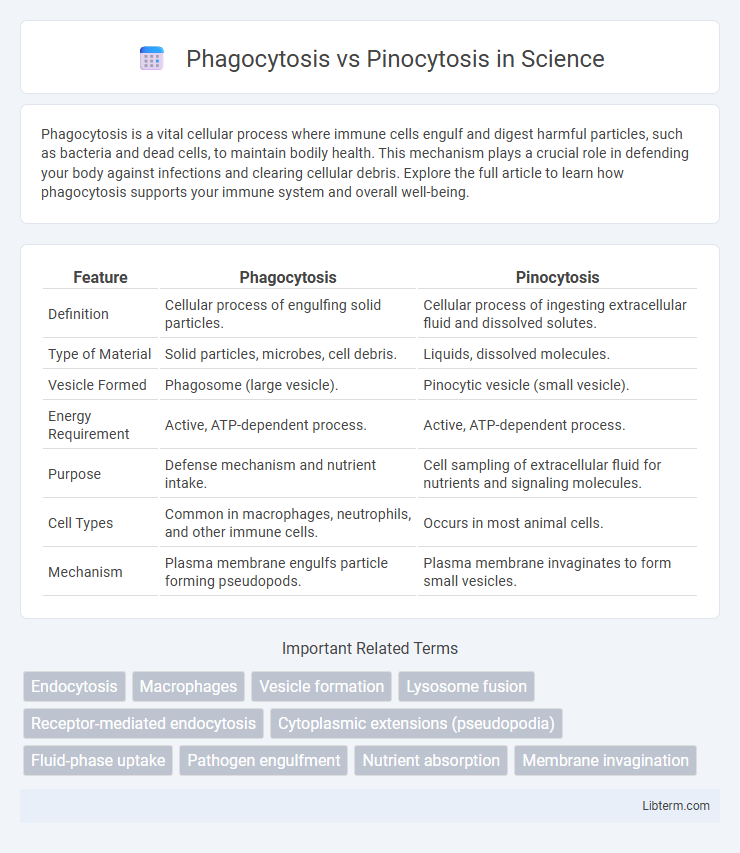Phagocytosis is a vital cellular process where immune cells engulf and digest harmful particles, such as bacteria and dead cells, to maintain bodily health. This mechanism plays a crucial role in defending your body against infections and clearing cellular debris. Explore the full article to learn how phagocytosis supports your immune system and overall well-being.
Table of Comparison
| Feature | Phagocytosis | Pinocytosis |
|---|---|---|
| Definition | Cellular process of engulfing solid particles. | Cellular process of ingesting extracellular fluid and dissolved solutes. |
| Type of Material | Solid particles, microbes, cell debris. | Liquids, dissolved molecules. |
| Vesicle Formed | Phagosome (large vesicle). | Pinocytic vesicle (small vesicle). |
| Energy Requirement | Active, ATP-dependent process. | Active, ATP-dependent process. |
| Purpose | Defense mechanism and nutrient intake. | Cell sampling of extracellular fluid for nutrients and signaling molecules. |
| Cell Types | Common in macrophages, neutrophils, and other immune cells. | Occurs in most animal cells. |
| Mechanism | Plasma membrane engulfs particle forming pseudopods. | Plasma membrane invaginates to form small vesicles. |
Introduction to Cellular Uptake Mechanisms
Phagocytosis and pinocytosis are essential cellular uptake mechanisms enabling cells to ingest extracellular materials; phagocytosis involves the engulfment of large particles or pathogens by specialized cells like macrophages, while pinocytosis allows the nonspecific uptake of extracellular fluid and dissolved solutes by virtually all cell types. Both processes rely on the dynamic remodeling of the plasma membrane and the formation of vesicles, which transport engulfed substances into the cell for digestion or processing. Understanding these mechanisms illuminates critical cellular functions in immunity, nutrient acquisition, and cellular homeostasis.
Defining Phagocytosis
Phagocytosis is a cellular process involving the engulfment of large particles such as bacteria or cellular debris, enabling the immune system to eliminate harmful invaders and maintain tissue homeostasis. It is characterized by the extension of pseudopodia that surround and internalize the particle into a vesicle called a phagosome. Unlike pinocytosis, which absorbs fluids and small molecules indiscriminately, phagocytosis is a selective, receptor-mediated mechanism critical for host defense and cellular cleanup.
Defining Pinocytosis
Pinocytosis is a cellular process where the cell engulfs extracellular fluid and dissolved solutes through the invagination of the plasma membrane, forming small vesicles. Unlike phagocytosis, which involves the uptake of large particles or cells, pinocytosis primarily handles fluid-phase endocytosis and nutrient absorption. This mechanism plays a crucial role in maintaining cellular homeostasis by regulating fluid and solute balance.
Key Differences: Phagocytosis vs Pinocytosis
Phagocytosis involves the engulfing of large particles such as bacteria or cellular debris, whereas pinocytosis is the process of ingesting extracellular fluid and dissolved nutrients. Phagocytosis forms large vesicles called phagosomes, while pinocytosis produces smaller vesicles known as pinosomes. The primary function of phagocytosis is defense and nutrient acquisition, contrasting with pinocytosis which mainly facilitates fluid and solute absorption in cells.
Mechanisms of Phagocytosis
Phagocytosis involves the recognition and engulfment of large particles such as bacteria or cellular debris through membrane extensions called pseudopodia that surround and enclose the target, forming a phagosome. The phagosome then fuses with lysosomes to form a phagolysosome where enzymatic degradation occurs. This receptor-mediated process is critical for immune defense and cellular cleanup, differing from pinocytosis, which nonspecifically internalizes extracellular fluids and solutes through small vesicles.
Mechanisms of Pinocytosis
Pinocytosis involves the cellular ingestion of extracellular fluid and solutes through small vesicles formed by the invagination of the plasma membrane. This process includes mechanisms such as clathrin-mediated endocytosis, caveolae-dependent uptake, and macropinocytosis, each facilitating specific molecular sorting and trafficking within the cell. Energy-dependent actin cytoskeleton remodeling drives vesicle formation and internalization, enabling efficient sampling of the extracellular environment in contrast to the large particle engulfment characteristic of phagocytosis.
Examples of Phagocytosis in Living Organisms
Phagocytosis is a crucial cellular process in immune system cells like macrophages and neutrophils, which engulf and destroy pathogens such as bacteria and cellular debris. Amoebas demonstrate phagocytosis by ingesting smaller protozoa or organic particles as a primary feeding mechanism. In humans, dendritic cells perform phagocytosis to capture antigens, initiating adaptive immune responses and maintaining homeostasis.
Examples of Pinocytosis in Biological Systems
Pinocytosis, a form of endocytosis, enables cells to ingest extracellular fluid and dissolved solutes, commonly observed in kidney proximal tubule cells where nutrient reabsorption occurs. Endothelial cells lining blood vessels use pinocytosis to sample plasma contents, maintaining homeostasis and facilitating transcytosis of molecules. This process contrasts with phagocytosis, which targets large particles like pathogens or cell debris, exemplified by macrophages engulfing bacteria.
Biological Significance and Functions
Phagocytosis and pinocytosis are vital cellular processes for material uptake, with phagocytosis specializing in engulfing large particles like pathogens and cellular debris, thereby playing a crucial role in immune defense and tissue homeostasis. Pinocytosis involves the non-specific ingestion of extracellular fluid and dissolved solutes, facilitating nutrient absorption and maintaining cellular fluid balance. Both mechanisms contribute significantly to cellular nutrition, waste removal, and immune system functioning by enabling cells to interact dynamically with their environment.
Summary: Choosing Between Phagocytosis and Pinocytosis
Phagocytosis involves the engulfment of large particles or cells, making it essential for immune defense and cellular cleanup, while pinocytosis is the process of ingesting extracellular fluid and small molecules, supporting nutrient absorption and membrane recycling. The choice between phagocytosis and pinocytosis depends on the target substance size and cellular needs; phagocytosis targets bigger, solid particles, whereas pinocytosis handles liquids and solutes. Efficient cellular functioning relies on selecting the appropriate endocytic pathway based on particle composition and physiological context.
Phagocytosis Infographic

 libterm.com
libterm.com